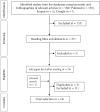Effects of Resistance and Combined training on Vascular Function in Type 2 Diabetes: A Systematic Review of Randomized Controlled Trials
- PMID: 31132077
- PMCID: PMC6760892
- DOI: 10.1900/RDS.2019.15.16
Effects of Resistance and Combined training on Vascular Function in Type 2 Diabetes: A Systematic Review of Randomized Controlled Trials
Abstract
Background: Cardiovascular disease (CVD) is the main cause of mortality in type 2 diabetes (T2D). Exercise can reduce the risk factors associated with CVD in T2D patients. However, research evaluating its beneficial effects in these patients has used different measurement protocols and types of exercise, complicating comparison.
Aim: To assess the effects of resistance training (RT) and combined training (CT) on the vascular function of T2D patients.
Methods: A database search (MEDLINE, Scopus, and Web of Science) was performed to identify relevant articles that were published up to August 2017. Only original studies evaluating the effects of RT or CT interventions on vascular function in T2D patients were included. The articles were reviewed independently by at least three reviewers. The Cochrane guidelines were used to assess the methodological quality of the studies. Fourteen studies were finally included. Two studies only used RT and twelve studies used CT as intervention strategy.
Results and conclusions: The results show that resistance training is a useful means for primary treatment of vascular diseases and maintenance of vascular function in T2D patients. However, more studies are necessary to gain full knowledge of the beneficial effects and to identify tailored exercise plans to optimize these benefits. The information provided in this review may help to improve current treatment of vascular diseases in T2D patients and to design future studies.
Conflict of interest statement
The authors report no conflict of interests.
Figures
Similar articles
-
The future of Cochrane Neonatal.Early Hum Dev. 2020 Nov;150:105191. doi: 10.1016/j.earlhumdev.2020.105191. Epub 2020 Sep 12. Early Hum Dev. 2020. PMID: 33036834
-
Effects of concurrent aerobic and resistance training on vascular health in type 2 diabetes: a systematic review and meta-analysis.Front Endocrinol (Lausanne). 2023 Sep 13;14:1216962. doi: 10.3389/fendo.2023.1216962. eCollection 2023. Front Endocrinol (Lausanne). 2023. PMID: 37780628 Free PMC article.
-
Effects of exercise training using resistance bands on glycaemic control and strength in type 2 diabetes mellitus: a meta-analysis of randomised controlled trials.Acta Diabetol. 2015 Apr;52(2):221-30. doi: 10.1007/s00592-014-0594-y. Epub 2014 May 21. Acta Diabetol. 2015. PMID: 24845604 Review.
-
Impact of Treating Oral Disease on Preventing Vascular Diseases: A Model-Based Cost-effectiveness Analysis of Periodontal Treatment Among Patients With Type 2 Diabetes.Diabetes Care. 2020 Mar;43(3):563-571. doi: 10.2337/dc19-1201. Epub 2019 Dec 27. Diabetes Care. 2020. PMID: 31882408
-
Effect of Exercise Intervention on Cardiac Function in Type 2 Diabetes Mellitus: A Systematic Review.Sports Med. 2019 Feb;49(2):255-268. doi: 10.1007/s40279-018-1003-4. Sports Med. 2019. PMID: 30357657
Cited by
-
Does Aerobic plus Machine-Assisted Resistance Training Improve Vascular Function in Type 2 Diabetes? A Systematic Review and Meta-Analysis of Randomized Controlled Trials with Trial Sequential Analysis.J Clin Med. 2022 Jul 22;11(15):4257. doi: 10.3390/jcm11154257. J Clin Med. 2022. PMID: 35893348 Free PMC article. Review.
-
The Effectiveness and Optimal Dose of Resistance Training in Patients With Subacute and Persistent Low Back-Related Leg Pain: A Systematic Review.Cureus. 2024 Mar 30;16(3):e57278. doi: 10.7759/cureus.57278. eCollection 2024 Mar. Cureus. 2024. PMID: 38559546 Free PMC article. Review.
-
Effects of Traditional Chinese Exercises on Glycemic Control in Patients with Type 2 Diabetes Mellitus: A Systematic Review and Meta-Analysis of Randomized Controlled Trials.Sports Med. 2024 Sep;54(9):2327-2355. doi: 10.1007/s40279-024-02046-9. Epub 2024 Jun 14. Sports Med. 2024. PMID: 38874898
-
Movement pattern definitions for resistance training behavior measurement in diabetes.Front Clin Diabetes Healthc. 2024 Aug 27;5:1447595. doi: 10.3389/fcdhc.2024.1447595. eCollection 2024. Front Clin Diabetes Healthc. 2024. PMID: 39258167 Free PMC article.
-
Effects of 12 Weeks of Resistance Training on Body Composition, Muscle Hypertrophy and Function, Blood Lipid Level, and Hemorheological Properties in Middle-Aged Obese Women.Rev Cardiovasc Med. 2023 Jul 12;24(7):196. doi: 10.31083/j.rcm2407196. eCollection 2023 Jul. Rev Cardiovasc Med. 2023. PMID: 39077025 Free PMC article.
References
-
- Guariguata L, Whiting DR, Hambleton I, Beagley J, Linnenkamp U, Shaw JE. Global estimates of diabetes prevalence for 2013 and projections for 2035. Diabetes Res Clin Pract. 2014;103(2):137–149. - PubMed
-
- Ogurtsova K, da Rocha Fernandes JD, Huang Y, Linnenkamp U, Guariguata L, Cho NH, Cavan D, Shaw JE, Makaroff LE. IDF Diabetes Atlas: Global estimates for the prevalence of diabetes for 2015 and 2040. Diabetes Res Clin Pract. 2017;128:40–50. - PubMed
-
- Arce-Esquivel AA, Bunker AK, Mikus CR, Laughlin MH. Insulin resistance and endothelial dysfunction: macro- and microangiopathy. [Accessed Sep 26, 2017]. Available from: http://www.intechopen.com/books/type-2-diabetes/insulin-resistance-and-e....
-
- Beckman JA, Creager MA, Libby P. Diabetes and atherosclerosis: epidemiology, pathophysiology, and management. JAMA. 2002;287:2570–2581. - PubMed
Publication types
MeSH terms
LinkOut - more resources
Full Text Sources
Medical


